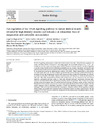Identificador persistente para citar o vincular este elemento:
https://accedacris.ulpgc.es/jspui/handle/10553/119283
| Título: | Fast regulation of the NF-kappa B signalling pathway in human skeletal muscle revealed by high-intensity exercise and ischaemia at exhaustion: Role of oxygenation and metabolite accumulation | Autores/as: | Gallego Sellés, Angel Galván Álvarez, Víctor Martinez Canton, Miriam García González, Eduardo Morales Álamo, David Santana Rodríguez, Alfredo González Henríquez, Juan José Dorado García, Cecilia López Calbet, José Antonio Martín Rincón, Marcos |
Clasificación UNESCO: | 32 Ciencias médicas 2302 Bioquímica 2411 Fisiología humana |
Palabras clave: | Fatigue ROS NF kappa B Performance Free radicals, et al. |
Fecha de publicación: | 2022 | Proyectos: | Desarrolloy Caracterización Molecular de Un Nuevo Modelo de Precondicionamiento Remoto Identificacion E Integracion de Nuevos Factores Moleculares, Fisiologicosy Bioelectricos Determinantes Del Rendimiento en El Ejercicio de Sprint Regulación de la oxidación de ácidos grasos durante la recuperación de ejercicios extenuantes. El papel de la FiO2 y los Radicales Libres Estudio longitudinal de los efectos de una modificación intensiva del estilo de vida en la composición corporal e indicadores bioquímicos y moleculares de salud en pacientes con sobrepeso y obesidad: aplicación para la evaluación fisiológica de rutas y sistemas de monitorización del esfuerzo ... |
Publicación seriada: | Redox Biology | Resumen: | The NF-κB signalling pathway plays a critical role in inflammation, immunity, cell proliferation, apoptosis, and muscle metabolism. NF-κB is activated by extracellular signals and intracellular changes in Ca2+, Pi, H+, metabolites and reactive oxygen and nitrogen species (RONS). However, it remains unknown how NF-κB signalling is activated during exercise and how metabolite accumulation and PO2 influence this process. Eleven active men performed incremental exercise to exhaustion (IE) in normoxia and hypoxia (PIO2:73 mmHg). Immediately after IE, the circulation of one leg was instantaneously occluded (300 mmHg). Muscle biopsies from m. vastus lateralis were taken before (Pre), and 10s (Post, occluded leg) and 60s after exercise from the occluded (Oc1m) and free circulation (FC1m) legs simultaneously together with femoral vein blood samples. NF-κB signalling was activated by exercise to exhaustion, with similar responses in normoxia and acute hypoxia, as reflected by the increase of p105, p50, IKKα, IκBβ and glutathione reductase (GR) protein levels, and the activation of the main kinases implicated, particularly IKKα and CaMKII δD, while IKKβ remained unchanged. Postexercise ischaemia maintained and stimulated further NF-κB signalling by impeding muscle reoxygenation. These changes were quickly reverted at the end of exercise when the muscles recovered with open circulation. Finally, we have shown that Thioredoxin 1 (Trx1) protein expression was reduced immediately after IE and after 1 min of occlusion while the protein expression levels of glutathione peroxidase 1 (Gpx1) and thioredoxin reductase 1 (TrxR1) remained unchanged. These novel data demonstrate that exercising to exhaustion activates NF-κB signalling in human skeletal muscle and regulates the expression levels of antioxidant enzymes in human skeletal muscle. The fast regulation of NF-κB at exercise cessation has implications for the interpretation of published studies and the design of new experiments. | URI: | https://accedacris.ulpgc.es/handle/10553/119283 | ISSN: | 2213-2317 | DOI: | 10.1016/j.redox.2022.102398 | Fuente: | Redox Biology [ISSN 2213-2317], v. 55, 102398 (Septiembre 2022) |
| Colección: | Artículos Artículos |
Citas SCOPUSTM
22
actualizado el 08-jun-2025
Citas de WEB OF SCIENCETM
Citations
19
actualizado el 08-jun-2025
Visitas
153
actualizado el 05-oct-2024
Descargas
56
actualizado el 05-oct-2024
Google ScholarTM
Verifica
Altmetric
Comparte
Exporta metadatos
Los elementos en ULPGC accedaCRIS están protegidos por derechos de autor con todos los derechos reservados, a menos que se indique lo contrario.
